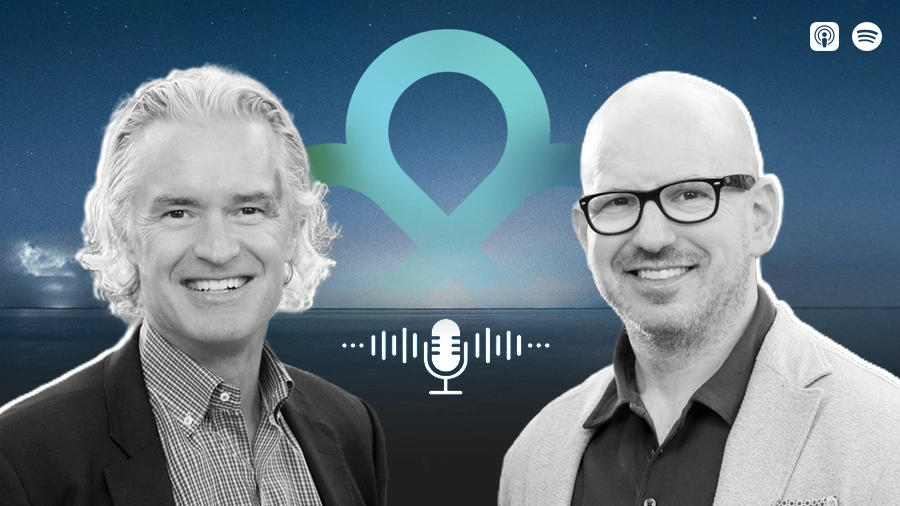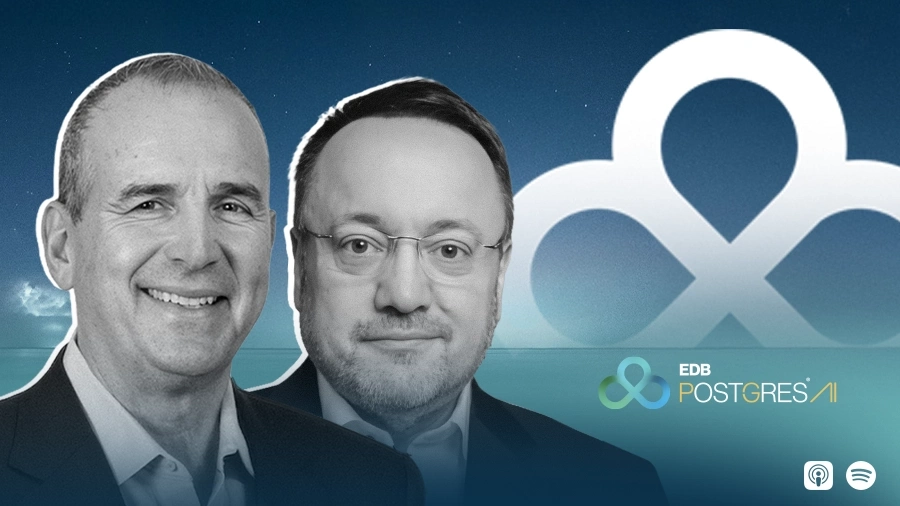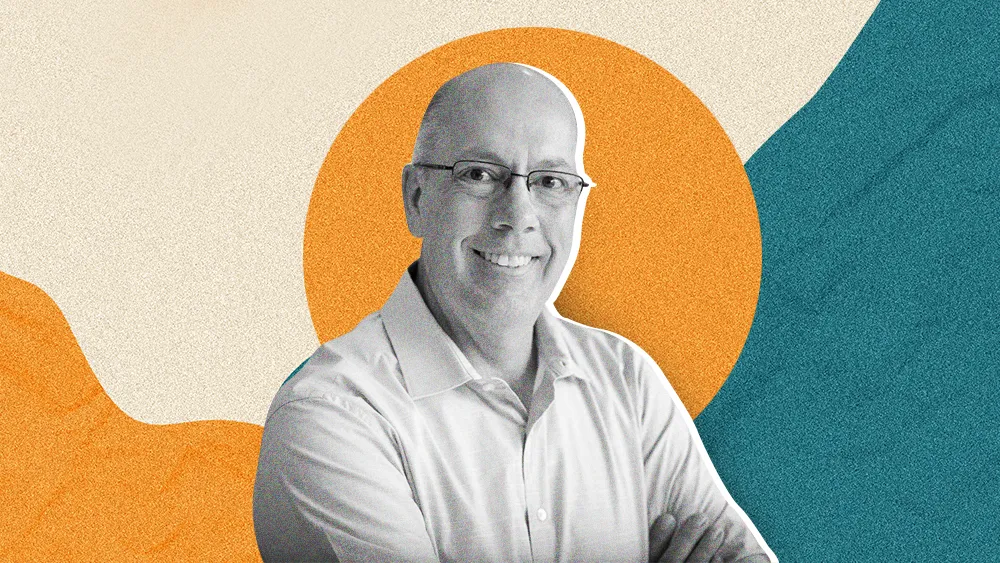Some business leaders are finding their decision-making models ill-equipped for the modern pace of change. While technology and markets accelerate along an exponential curve, the human mind still tends to think linearly. Now, this fundamental mismatch is causing executives to overlook early disruptive signals, often acting only after nimbler competitors have gained a significant lead.
In a recent conversation on the AI & Data Horizons podcast, EDB's CMO Michael Gale spoke with Deloitte's Steven Goldbach, Sustainability Practice Leader, and Geoff Tuff, Global and US Sustainability Leader for Energy, Resources, and Industrials. Together, the Deloitte strategists are also co-authors of Detonate, Provoke, and the national bestseller, Hone. In the pages of their books and on the airwaves, the two describe a framework for leaders navigating the radical shift from simply reacting to proactively provoking change.
For Gale and his listeners, the subject is utterly fascinating. "It's a really interesting combination of business process, psychology, how historical failure can drive success, and success can drive future failure. Where do we start in this conversation?" Tuff suggests they begin with "the most logical place:" the shifting nature of change itself. Introducing Moore's Law, he explains how computing power has demonstrated an exponential curve for more than a hundred years. "But we're now starting to see all sorts of other things that are also showing signs of being exponential."
Wired for yesterday: "As leaders and as organizations, we are genetically wired to think linearly," Tuff says. "When that natural instinct collides with the reality that the world is becoming more exponential, real issues arise." Unfortunately, the result is a losing race. "If you only react to an exponential shift, at the point that you see it, it's going to be too late," he continues. "That's just the nature of exponential change."
According to Goldbach and Tuff, the solution is a framework for categorizing uncertainty. With its guidance, leaders can better distinguish between "if" uncertainties, which may or may not happen, and "when" uncertainties, which are guaranteed to occur even if the timeline is unclear. "Can you give some examples of where you've seen good and bad of this?" Gale wonders.
Dismissing the decimal: The rise of cable-cutting is a classic cautionary tale, Goldbach explains. "We took it to one competitor, and they almost laughed us out of the room. They dismissed the 1.75% signal, saying it was such a small, irrelevant segment that it didn't matter. But it was an early indication of something that was demonstrably better. Had the executives in question reacted, they would have been wildly more successful."
For Goldbach, understanding the concept of 'if to when' is essential. "It measures the impact those exponential technologies would have on business models, should they ever come to fruition. Failing to act on a "when" trend often causes companies to become what the authors call unintentional "wind-down firms."
Decline by design: "Is there a moment where 'wind down' becomes a reality?" Gale asks. "Or, by the time it becomes reality, is it too late for change?" Tuff replies, "Ideally, if you end up becoming a 'wind down firm,' you do it because it's an active choice." And Goldbach adds, "I think this point is critical for almost every company in existence today."
Exit strategy: "A strategic wind-down, where you recognize the best way they can create shareholder value is to continue to extract oil out of the earth," Tuff continues. "That's a very different proposition than suddenly realizing that you have to wind down because you're going out of business." The global energy sector's decarbonization challenge is a prime example, Goldbach adds. Still, the choice is one "for almost every company in existence today."
"Have you seen sectors where the speed effect is affecting things faster than others?" Gale asks. "It's very difficult to identify any sector that isn't impacted in some way by the accelerating effect or exponential change," Tuff explains. Ultimately, the situation leaves leaders with a choice between two paths: manage a decline or commit to a "continual state of evolution"—a state for which most organizations are simply not prepared.
Hardwired for failure: The diagnosis begins with "fatal flaws" at the individual level—cognitive biases that are inherently human. "Let's walk through these fatal flaws so people can make their own diagnosis," Gale suggests. But first, Goldbach offers a caveat: "I think it's important to note that these fatal flaws are not because people are evil. They're just inherently human."
Anatomy of inaction: "We have an aversion to loss, so any change from the status quo is usually associated with losing something," Goldbach explains. "We also have the affect heuristic, where unless things impact us in a strong way emotionally, we tend to underweight it."
Meanwhile, a culture of excessive politeness prevents uncomfortable truths from ever being discussed. "Fatal flaws, these inherent human bias issues, are obvious when mentioned, but rarely talked about," Gale affirms. "What will encourage people to talk about these ideas as active principles?" he wonders. The reason so many leaders miss these key turning points lies in what the authors called a "systems problem."
Death by consensus: As a result, teams tend to miss the very clear and present data that signals a coming disruption. "The real challenge is what happens when you put those individual biases into organizations where we tend to be very polite and do things like take conversations 'offline' to avoid disagreement," Goldbach explains. "If you combine that with the crumbling bandwidth of leadership, you get a sense that organizations are also blinded."
Experience as liability: The implication is that hard-won experience, once a reliable guide, can become a liability. The "gut instinct" that made many leaders successful can fade when linear assumptions meet exponential change, Tuff says. "In a world of exponentials, what we've learned from the past and what the 'experts' know is not what will help us create advantage in the future."
To overcome these flaws, leaders must install new mechanisms for seeing the world clearly. The first step is to create a culture where biases and orthodoxies are "discussable," naming them openly so they can be challenged.
Discuss and conquer: "Encourage people to question why things are done a certain way and to ask if those reasons are still valid, because we know that we need to shift," Tuff advises. Such a culture of psychological safety allows teams with different life experiences to counteract individual blind spots. "And that's why diversity is not just a moral imperative," Goldbach adds. "It's a business imperative."
Eventually, that open and diverse discussion becomes the raw material for the final tool: abandoning a single vision of the future to adopt systematic scenario planning. "We expect to see more organizations adopt systematic scenario thinking," Goldbach says. "Instead of debating what will for sure be true, leaders should be talking about what they're uncertain about and discussing different possible futures. That process is absolutely critical to creating visibility."
A key catalyst for this change is that uncertainty has become a tangible, lived reality. As Tuff reflects, the pandemic has given society at large a "fundamental and visceral understanding" of what that uncertainty feels like. For all its horror, that shared experience has primed leaders to accept the fragility of their linear assumptions. And as Gale notes at the conversation's close, "Given COVID-19 as a terrible reminder of what exponential change can look like if you are not prepared for it, this is a great guiding principle for the future."









